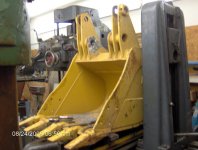CC
Aluminum
- Joined
- Mar 14, 2006
- Location
- NW Pennsylvania
My company builds very large mill equipment that utilizes large pin joints. The weldments weigh as much as 6500 lbs. For 40 years we clamped the weldment to the mill table (50" x 50") and then bored 4" to 6" holes thru multiple plates that may be 36" wide. There is an arbor support available but they never took the time to set it up. Did I mention that the material was A514? We use brazed carbide lathe tooling in a large bar. They extend the spindle as far out as needed then feed the part into the spindle. The spindle speed and feed must be extremely slow because the spindle is extended so far. I want to try using the arbor support but can't convince the shop to try it. Anyone have any thought on using an arbor support?




